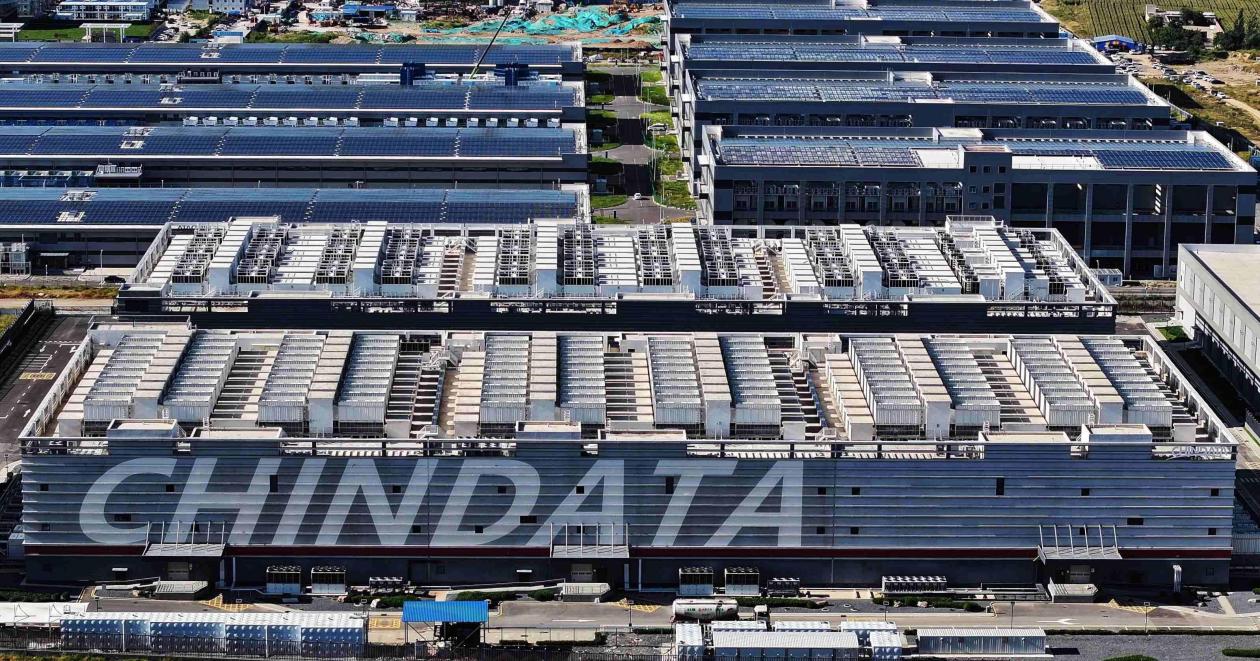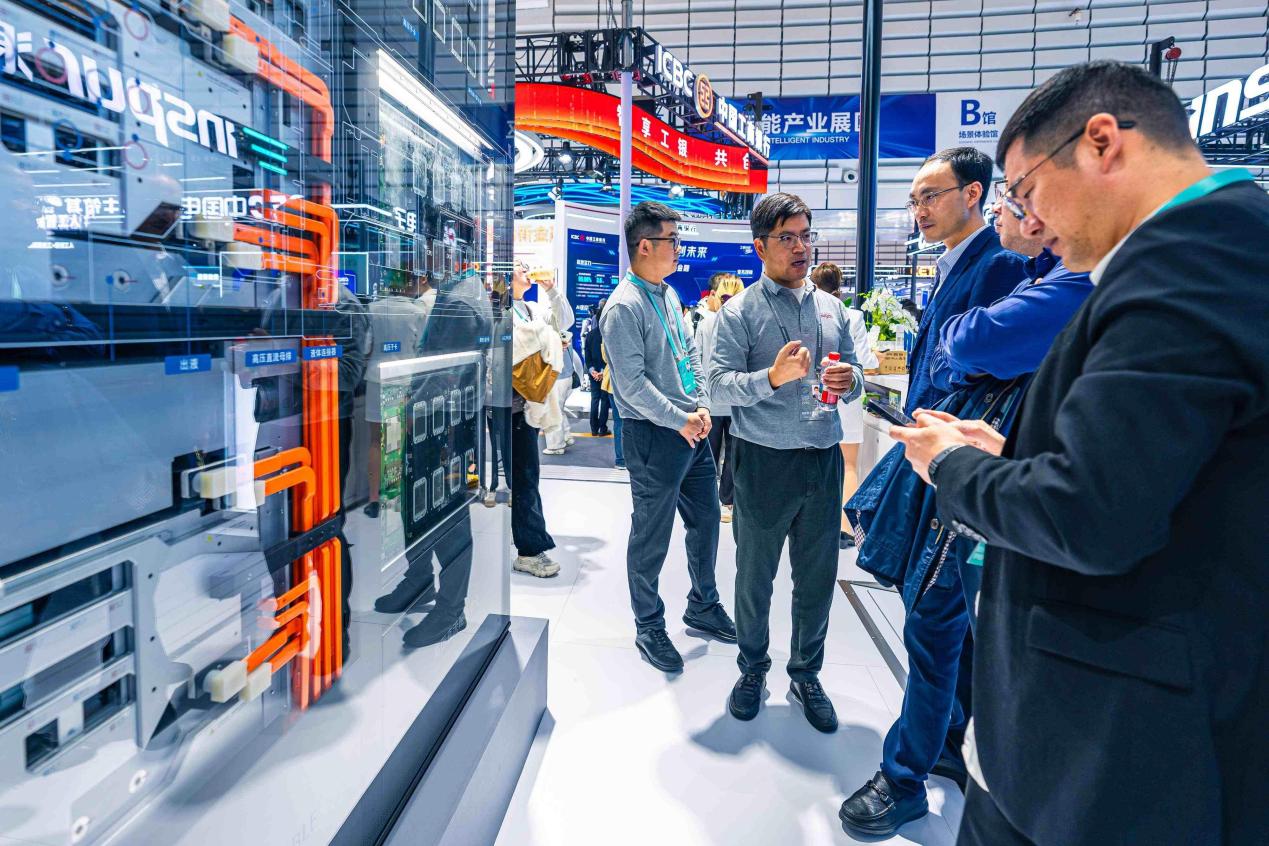




- BRNN
- BRI News
- BRNN News
- Database
Official Documents Polices and Regulations
Inter-government Documents International Cooperation BRI Countries
Business Guide Economic Data BRI Data
Trade
Investment Projects Latest projects
Cases - Content Pool

Photo shows a big data industrial park in Huailai county, Zhangjiakou, north China's Hebei province. (Photo/Chen Xiaodong)
Driven by cutting-edge artificial intelligence (AI) theories and advanced computing architecture, China's intelligent computing capacity is providing strong support for the development of AI.
According to statistics released by China's Ministry of Industry and Information Technology, as of the end of June 2025, China had 10.85 million standard racks in operation nationwide, with its intelligent computing power reaching 788 EFLOPS and storage capacity exceeding 1,680 exabytes.
China has released 1,509 large AI models, ranking among the top globally. Meanwhile, intelligent computing is increasingly integrated across industries, providing a foundational engine for innovation and industrial transformation.
By leveraging intelligent computing for efficient AI model training and inference, innovation in scientific research has accelerated significantly. Universities, research institutes, and computing enterprises across China are intensifying collaboration to expand intelligent computing applications across scientific domains.
At the Intelligent Computing System Lab of China's Nankai University, researchers employed a high-efficiency open-source AI framework to enhance the inference speed of fundus image analysis by 2.4 times in vascular segmentation studies, facilitating the clinical viability of retinal imaging technologies.
The Shanghai AI Laboratory, LinGang Laboratory, Shanghai Jiao Tong University, and Fudan University collaborated to identify and validate two new cancer targets within just two months, demonstrating the accelerating pace of scientific discovery enabled by intelligent computing.

A supercomputer developed by China's leading supercomputer manufacturer Dawning Information Industry Co. Ltd., or Sugon, is exhibited at the Light of Internet Expo held in Wuzhen, east China's Zhejiang province, Nov. 8, 2025. (Photo/Zhang Feng)
Meanwhile, the Pengcheng Laboratory has integrated computing nodes from more than 20 cities via the China Computing Net. Supported by its "Peng Cheng Cloud Brain II," the platform now supports tens of thousands of researchers nationwide.
At the Yili Modern Intelligent Health Valley, a dairy production complex owned by Chinese dairy giant Yili Group in Hohhot, north China's Inner Mongolia autonomous region, each dairy cow has an individual digital health record. Leveraging intelligent computing capacity provided by Alibaba Cloud and its Apsara operating system, Yili Group has established an intelligent computing infrastructure that offers a stable and flexible environment for deploying AI applications. Decision-making algorithms and generative AI models have been integrated into production and supply chain management.
"Traditional, manual methods for monitoring cow health are inefficient and prone to subjectivity," said Cheng Guoqiang, director of digital technology at Yili Group's digital technology center. "Now, with computer vision technology analyzing features such as eye condition, we can conduct real-time health monitoring and implement precision feeding, which has significantly enhanced milk quality."
"Yili Group has developed more than 800 intelligent agents so far," said Jia Zhaohui, senior director of solutions at Alibaba Cloud. "Large models cover 70 percent of supply chain scenarios, including order fulfillment, inventory turnover, and logistics efficiency, greatly reducing the risks of raw material expiration, stockpiling, and shortages."
Since open-sourcing its first Qwen model in 2023, Alibaba has recorded over 600 million global downloads, with more than 170,000 derivative models developed, demonstrating the rapid proliferation and adaptability of its AI technology.
As high-speed train performance continues to increase, aerodynamic design has become a key focus in research and development. CRRC Corporation Limited, China's leading train maker, has leveraged its extensive simulation and experimental data to build a standardized aerodynamic load database for high-speed trains. Using the deep-learning platform PaddlePaddle and its scientific computing suite, developed by Chinese tech giant Baidu, the company has developed an intelligent aerodynamic simulation model.

GPUs are manufactured in a workshop of a tech firm in Nanchong, southwest China's Sichuan province. (Photo/Yang Bo)
Compared with traditional simulation methods, the new large model reduces the simulation cycle from several days on traditional supercomputers to approximately 10 seconds on a single GPU. The overall simulation efficiency has increased by more than 30 times, with results deviating by less than 5 percent, marking a significant leap forward in intelligent optimization and rapid aerodynamic design.
Experts said that coordinated design and deep integration of software and hardware, along with continuous innovation in AI computing architecture, are essential to further integrate technologies such as large models and intelligent agents into the real economy, enabling AI to become a source of innovation across all industries.
"Innovation in intelligent computing relies on collaboration among enterprises, universities, and research institutions, as well as strong talent support," said Hong Yuan, chief product officer of Tecorigin, a Chinese technology company specializing in high-performance AI chip architecture and intelligent computing systems.
The company has established joint research and development teams with Hunan University, Nanjing University of Posts and Telecommunications, and Soochow University to tackle research challenges. It has also developed an AI education and training platform based on its self-developed acceleration cards and software-hardware solutions, cultivating a skilled and practically oriented generation of young talent.
At present, the company's high-density liquid-cooled intelligent computing clusters serve more than 200 universities and enterprises, supporting computing workloads exceeding 1.2 petaflops.

Tel:86-10-65363107, 86-10-65368220, 86-10-65363106